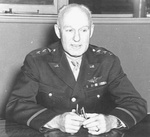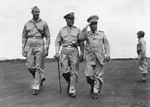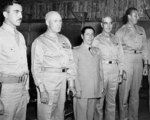George Brett
| Surname | Brett |
| Given Name | George |
| Born | 7 Feb 1886 |
| Died | 2 Dec 1963 |
| Country | United States |
| Category | Military-Air |
| Gender | Male |
Contributor: C. Peter Chen
ww2dbaseGeorge Howard Brett was born in 1886 as the second of five children of librarian William Howard Brett and Alice Brett (née Allen). In 1902, Brett's older brother, Morgan Brett, entered the United States Military Academy at West Point, New York, United States. When it came time for George Brett, his parents were not able to secure another recommendation to attend the elite military academy, thus Brett entered the Virginia Military Institute in Lexington, Virginia, United States, graduating in 1909. Between 1910 and 1911, he served in the Philippine Islands. Returning to the US in May 1912, he served at Fort Bliss in Texas and Fort Ethan Allen in Vermont through 1916. In Sep 1916, he transferred to the Aviation Section of the US Army Signal Corps and served in the office of the Chief Signal Officer in Washington DC, United States. In Nov 1917, Captain Brett departed the US for Europe for participation in WW1. Appendicitis caused him to be removed from the list of eligible pilots, thus he remained in the rear as a logistics officer at the headquarters of Brigadier General Billy Mitchell in France. Between Aug and Sep 1918, he briefly served as the Director of Military Aeronautics of the US Army in Washington DC. When WW1 ended, he was the commanding officer of the US Army Air Service Camp at Codford, England, United Kingdom.
ww2dbaseIn the years after WW1, Brett successively served as the commanding officer of the Aviation General Supply Depot at Kelly Field in Texas, the maintenance and supply officer at the Air Service Flying School at Morrison in Virginia, and the Director of the Air Service in Washington DC. In 1920, he was promoted to the permanent rank of major. In late 1920, he was named the commanding officer of Crissy Field in San Francisco, California, United States. In 1923, his oldest son, Devol Brett, was born; his oldest son would many years later join the US Air Force and achieve the rank of lieutenant general. Between 1924 and 1927, he was assigned to the intermediate depot at Fairfield, Ohio, United States. He attended the Air Corps Tactical School at Langley Field in Virginia in Jun 1927, followed by the Command and General Staff School at Fort Leavenworth in Kansas, United States. After some time as the commanding officer of Selfridge Field in Michigan, United States, he returned to Fort Leavenworth as an air instructor in 1933. After completing courses at the Army War College, he was promoted to the permanent rank of lieutenant colonel and temporary rank of brigadier general, and was given command of the 19th Wing at the Panama Canal Zone. After serving as the chief of staff to General Frank Andrews at Langley, Virginia, he was transferred to Wright Field near Riverside, Ohio, United States to serve, simultaneously, as the assistant to the chief of the US Army Air Corps, the commandant of the Air Corps Engineering School, and the chief of the Materiel Division. In Nov 1939, he was named the acting Chief of the Air Corps, filling the position, on a temporary basis, that Henry Arnold vacated as Arnold joined the Army General Staff. In Oct 1940, he was promoted to the rank of major general. In May 1941, he was officially named the Chief of the Air Corps. Before the United States entered WW2, he was posted to the United Kingdom; he recommended the establishment of American factories in Britain to repair and manufacture military aircraft, but this recommendation would be rejected by Arnold. In a subsequent visit to the Middle East, he voiced some opinions about the war situation that offended British Ambassador to Egypt Sir Miles Lampson, British Air Marshal Arthur Tedder, and others. He was recalled to the United States in Dec 1941.
ww2dbaseAs the United States entered WW2, Brett traveled to Rangoon in Burma and Chongqing in China to meet with British chief Archibald Wavell and Chinese President Chiang Kaishek. On 1 Jan 1942, he was named the Deputy Supreme Commander of the American-British-Dutch-Australian Command (ABDA); six days later, he was promoted to the rank of lieutenant general. One of his earlier tasks as the chief of the small US Army contingent in Australia was to dispatch aircraft to pick up Douglas MacArthur in the Philippine Islands, who had been ordered by US President Franklin Roosevelt to evacuate to Australia; failing to secure the loan of new US Navy B-17 aircraft to accomplish this mission, he had no choice but to send several old and unreliable US Army B-17 bombers for the task, all of which suffered serious mechanical problems, infuriating MacArthur. In Apr 1941, he was named the chief of the Allied Air Forces, Southwest Pacific Area based in Melbourne. When given the order to launch B-17 bombers to attack Japanese positions in the Philippine Islands, Brett initially protested; for this, he again was viewed negatively by MacArthur. By Jul 1942, MacArthur had grew tired of the constant disagreements, and secured the transfer of Major General George Kenney to this theater to replace Brett. He was awarded the Silver Star medal, personally by MacArthur, before departing Australia on 4 Aug 1942 aboard B-17 bomber "The Swoose". In Nov 1942, he received his next post as the head of both the US Caribbean Defense Command and the US Army's Panama Canal Department; he would be in Panama Canal Zone for the remainder of the war. While at the US Caribbean Defense Command, Brett became involved in an investigation over the misuse of Army funding and property; although Lieutenant General Daniel Sultan would find no fault on the part of Brett, Brett nevertheless requested voluntary retirement shortly after. He retired on 30 Apr 1945, but he was recalled back to service on the following day to his previous post.
ww2dbaseBrett again retired from the US Army in May 1946. In 1948, by an Act of the United States Congress, he was promoted to the rank of lieutenant general while on the retired list. He served on several committees and boards related to the US Army and the newly established US Air Force. He passed away from cancer in 1963 and was buried in Winter Park, Florida, United States.
ww2dbaseSource: Wikipedia
Last Major Revision: Dec 2012
Photographs
 |  |  |  |
George Brett Timeline
| 7 Feb 1886 | George Brett was born in Cleveland, Ohio, United States. |
| 22 Mar 1910 | George Brett was commissioned a second lieutenant of the Philippine Scouts of the US Army. |
| 10 Aug 1911 | George Brett transferred from the Philippine Scouts to the 2nd Cavalry Regiment within the US Army. |
| 1 Mar 1916 | George Brett married Mary Devol, daughter of Major General Carroll Devol. |
| 1 Jul 1916 | George Brett was promoted to the rank of first lieutenant. |
| 2 Sep 1916 | George Brett transferred to the Aviation Section of the US Army Signal Corps. |
| 15 May 1917 | George Brett was promoted to the rank of captain. |
| 7 Jun 1918 | While in France, George Brett was promoted to the temporary rank of major. |
| 1 Aug 1918 | George Brett was attached to the Director of Military Aeronautics of the US Army in Washington DC, United States. |
| 23 Sep 1918 | George Brett stepped down as the Director of Military Aeronautics of the US Army in Washington DC, United States. |
| 1 Aug 1923 | Devol Brett, the oldest son of George Brett, was born at the Letterman Army Hospital at the Presidio, San Francisco, California, United States. |
| 1 Oct 1940 | George Brett was promoted to the rank of major general. |
| 28 Dec 1941 | George Brett arrived in Darwin, Australia. |
| 1 Jan 1942 | George Brett was named the Deputy Supreme Commander of the American-British-Dutch-Australian Command (ABDA). |
| 5 Jan 1942 | George Brett was named the commanding officer of all US forces in Australia. |
| 7 Jan 1942 | George Brett was promoted to the temporary rank of lieutenant general. |
| 23 Feb 1942 | George Brett departed Java, Dutch East Indies for Australia. |
| 24 Feb 1942 | George Brett arrived in Melbourne, Australia and assumed command of US Army Forces in Australia. |
| 11 Mar 1942 | George Brett dispatched 4 B-17 Flying Fortress bombers, with skeleton crew, from Melbourne, Victoria, Australia to Batchelor Field near Darwin, Northern Territory, Australia, via Daly Waters, Northern Territory; these aircraft were meant to be used to evacuate Douglas MacArthur and his family and staff from the Philippine Islands. |
| 20 Apr 1942 | Major General George Brett assumed command of Allied air forces in Australia. |
| 3 Aug 1942 | George Brett was awarded the Silver Star medal by Douglas MacArthur in Australia. |
| 4 Aug 1942 | George Brett departed Australia for the United States aboard B-17 Flying Fortress aircraft "Swoose". |
| 30 Apr 1945 | George Brett retired from the US Army. |
| 1 May 1945 | George Brett was reactivated from the US Army retired list. |
| 10 Oct 1945 | George Brett stepped down as the chief of the US Caribbean Defense Command and the US Army's Panama Canal Department. |
| 10 May 1946 | George Brett retired from the US Army at the rank of major general. |
| 29 Jun 1948 | George Brett was promoted to the rank of lieutenant general while on the retired list. |
| 2 Dec 1963 | George Brett passed away at the hospital at Orlando Air Force Base in Orlando, Florida, United States. |
Did you enjoy this article or find this article helpful? If so, please consider supporting us on Patreon. Even $1 per month will go a long way! Thank you. Share this article with your friends: Stay updated with WW2DB: |
- » Wreck of USS Edsall Found (14 Nov 2024)
- » Autumn 2024 Fundraiser (7 Nov 2024)
- » Nobel Peace Prize for the Atomic Bomb Survivors Organization (11 Oct 2024)
- » Wreck of USS Stewart/DD-224 Found (2 Oct 2024)
- » See all news
- » 1,150 biographies
- » 337 events
- » 43,917 timeline entries
- » 1,241 ships
- » 350 aircraft models
- » 207 vehicle models
- » 374 weapon models
- » 123 historical documents
- » 260 facilities
- » 470 book reviews
- » 28,541 photos
- » 432 maps
Winston Churchill
Please consider supporting us on Patreon. Even $1 a month will go a long way. Thank you!
Or, please support us by purchasing some WW2DB merchandise at TeeSpring, Thank you!